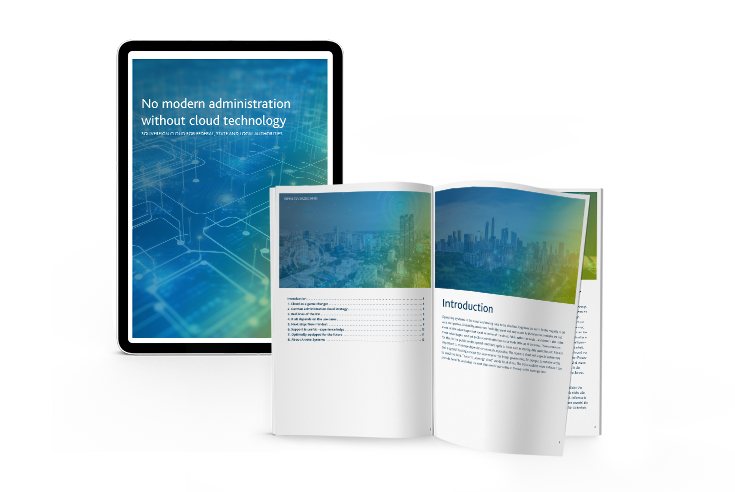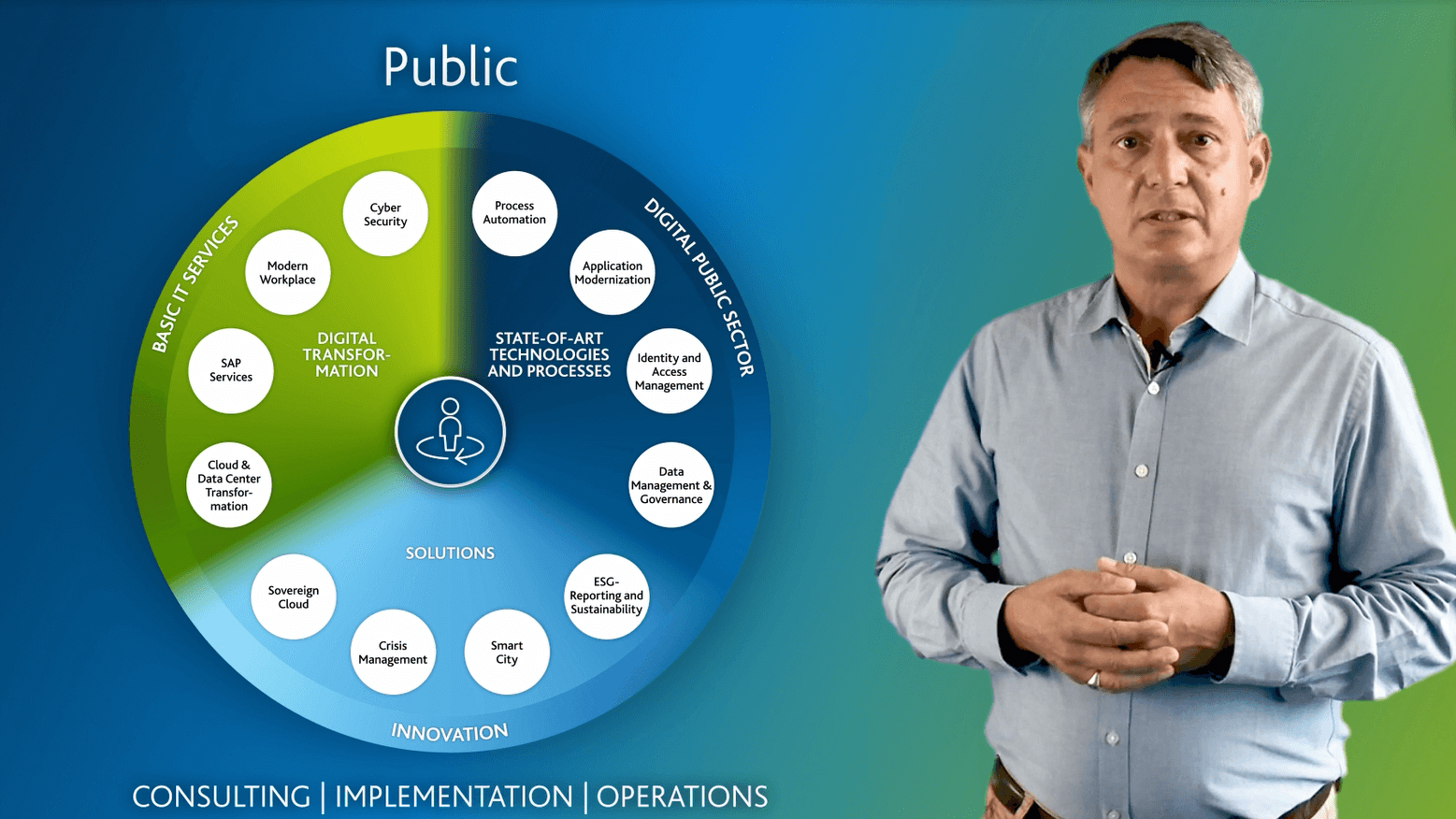
Modern IT Solutions for Public Administration
We will take the next step into the digital future together
Digitization of Public Administration
The comprehensive digitization of public administration is an important challenge. It offers great advantages in the area of process and cost optimization, as services such as cloud systems facilitate work in specialized procedures. The focus is also on the security of all data of citizens and administrations.
The desire of citizens to be able to do things independently and securely online grows steadily. But also the employees of the administration do not want to do without the use of the most modern technologies, which facilitate their work and further improve citizen services. The work processes in municipal administrations must be made more attractive and self-determined through digital solutions, especially for young professionals.


Our mission is to support you in your transformation and to start the digital future together with you. With our numerous IT services, which are tailored to the specific requirements of the public sector, we are at your side, from IT consulting to system integration and cyber security. In the process, you will benefit from our technological expertise as well as our high quality and security standards. We look forward to developing customized solutions with you and accompanying you as your strategic partner.

Together with Arvato Systems, we want to accompany the administration on its way to the Sovereign Cloud. We enable our customers to gain valuable technological and organizational experience with the cloud environment - even before it is available - and take the first steps in a Sovereign Cloud.
Worth Knowing about the Digital Transformation in Public Administration
-
What is a sovereign cloud?
The objective of a sovereign cloud is to reduce dependence on foreign cloud providers and to retain control over one's own data. It should be ensured that direct access from outside is excluded through technical measures. The operation can be carried out by the government itself or by a selected organization. This is particularly important for government agencies, critical infrastructures and other organizations that work with sensitive data. In this way, they also have the option of using globally established technologies under local sovereignty criteria.
-
What is a smart city?
A smart city is a city that uses technology and data to manage its resources more efficiently and improve the lives of its residents. This includes issues such as traffic control, energy supply, neighborhood planning, public safety, waste management, democratic participation, and various social issues. In a smart city, the needs of residents and the public interest are at the center, and policy-makers and the public sector use technology to make better decisions, for example, in urban planning.
-
Where does artificial intelligence help in the public sector?
Artificial intelligence (AI) can help in the public sector in various areas, such as improving services, optimising processes and gaining insights from data.
There are numerous use cases in which AI is applied in the public sector. For example, it can be tailored to specific needs and assist in personalising services. AI can also be used to improve processes to increase public sector workflow efficiency. Another possible application is the prediction of risks. This can help government agencies respond faster and more effectively in crises. Likewise, it is possible to optimize the automation of decisions through AI. And data analysis, where AI systems gain insights from large amounts of data, is another important point. These insights can be an important support for government agencies to make informed decisions.
-
How does cyber security work in public administration?
Cyber security in public administration is an important aspect of ensuring that public authorities and government organizations are protected from cyber attacks and that their data and systems become resilient.
Cyber attack methods can vary and are constantly evolving. It is important that businesses and organizations are aware of what cyber-attacks can look like and what protective measures they should take to protect themselves. This includes using anti-malware software, implementing security policies and training employees on how to identify cyber threats.
Common forms of cyber-attacks include phishing, where cybercriminals send fake emails to infect systems with malicious software (malware, ransomware), for example - often to extort a ransom for unblocking systems. Social engineering, meaning the manipulation of employees to obtain sensitive data, is also widespread;,as are so-called denial-of-service attacks, which aim to overload servers in order to put them out of operation.
By following basic steps, cyber security can also be improved in public administration:
1) Identify vulnerabilities: Public sector actors need to regularly scan and identify vulnerabilities in their systems and networks to ensure that they are adequately protected.
2) Risk assessment: They need to assess the risk of cyber-attacks and prioritize to target and use their resources more effectively.
3) Protective measures: They should put in place security measures such as firewalls, encryption, anti-malware software, and access controls to secure their systems and networks.
4) Employee training: They need to train their employees on the importance of cyber security to ensure they are aware of threats and how to recognize and respond to them.
5) Incident Response Plan: They should create an incident response plan that describes how they will respond to cyber-attacks, including steps to recover systems and data.
6) Collaboration and information sharing: Public authorities and the private sector should work closelyand share information on cyber threats and attacks to strengthen their defenses jointlys.
-
What will a digital office workplace look like in the future?
Today, the digital office workplace is already strongly characterized by technology. There are several aspects to a modern digital workplace:
1) Cloud-based software: Software applications are stored in the cloud so that employees can access them from anywhere.
2) Artificial intelligence: Artificial intelligence (AI) automates repetitive tasks such as data processing and document management.
3) Mobile devices: Mobile devices such as smartphones and tablets facilitate mobile work for employees from anywhere. It also strengthens team collaboration.
4) Cybersecurity: The focus is on the security of the digital workplace to effectively protect data and systems.
-
What does automation in public authorities and specialist procedures look like in the future?
Automation in public authorities and specialized procedures is an important focus of digitalization in the public sector. Automation can make processes faster, more efficient, and error-free. Here are some examples of automation in public authorities and specialized procedures:
1) Automated application procedures: By implementing online forms and automated processes, applications can be processed faster.
2) Automated document management: Documents can be managed faster and more efficiently through automated processes. By implementing document management systems, documents can be automatically sorted, archived, and searched.
3) Automated billing processes: In many public authorities, billing is still done manually. By implementing automated accounting procedures, errors can be reduced and time saved.
4) Automated human resources management: By implementing automated human resources management systems, processes such as recruitment, payroll, and working time management can be handled faster and more efficiently.
5) Automated information processing: By implementing artificial intelligence and "machine learning", information can be processed and analyzed automatically. Automated systems are used to analyze data from sensors and cameras.
6) Automated approval procedures: Approval procedures can be accelerated through automated workflows and processes. For example, automated systems can be used to process building applications faster.
Certifications
Rely on us: information security, quality management, IT service management. For our customers, we regularly have our performance measured and extensively certified. You benefit in the long term from our adherence to the highest quality standards and our technological expertise in the form of a trusting and highly professional collaboration.

Your Contact for Public Administration






























